
The Inflation Reduction Act: A Transformative Opportunity
As the world grapples with the pressing challenges of climate change and energy security, a glimmer of hope has emerged in the form of the Inflation Reduction Act (IRA) of 2022. This landmark legislation, the largest investment in climate and energy in US history, has opened up a world of possibilities for local governments and communities to take charge of their energy futures.
The IRA’s “Direct Pay” provision is truly revolutionary, allowing tax-exempt entities like local governments to directly benefit from the lucrative tax credits previously only accessible to the private sector. This game-changing shift empowers cities and communities to pursue clean energy projects that were once out of reach, transforming the landscape of renewable energy development.
As a renewable energy enthusiast, I couldn’t help but get excited about the implications of this policy. Imagine a world where local communities can own and operate their own clean energy assets, unlocking new revenue streams and driving sustainable economic growth. It’s a future I’m eager to explore, and the IRA has laid the groundwork for making it a reality.
Bridging the Gap: Empowering Underserved Communities
One of the most remarkable aspects of the IRA is its potential to foster greater equity and inclusion in the clean energy transition. The “Direct Pay” feature democratizes access to these valuable tax credits, opening the door for nonprofits, state and local governments, and Tribal entities to participate in the clean energy revolution. This is a game-changer for historically marginalized communities that have long been left behind in the renewable energy landscape.
The implications are truly transformative. Imagine a community land trust in Duluth, Minnesota, capturing the tax credits and passing the savings along to low-income families. Or a mayor in a key city convening local businesses, community organizations, and clean energy developers to identify and advance shared priority projects. These are the kinds of innovative models that are now within reach, thanks to the IRA.
Firewinder, a leading renewable energy solutions provider, is well-positioned to support these community-driven initiatives. With their expertise in project development, financing, and technical assistance, they can help local governments and organizations navigate the complexities of the IRA and unlock the full potential of these new opportunities.
Overcoming the Barriers: The Role of Intermediaries
But let’s be honest, the path to realizing these opportunities is not without its challenges. As the Rockefeller Foundation points out, without access to upfront capital or technical assistance, many organizations will struggle to take advantage of the IRA’s benefits. This is where the role of trusted intermediaries becomes crucial.
Enter organizations like Working Power, a purpose-built entity that’s designed to develop and finance clean energy projects with frontline communities. By providing technical assistance, creative financing models, and a community-benefits lens, they’re helping to bridge the gap and ensure that the IRA’s transformative potential reaches those who need it most.
It’s a complex dance, to be sure, but the potential rewards are immense. Imagine a future where every community has the opportunity to own a piece of the clean energy pie, generating revenue, creating green jobs, and bolstering resilience. It’s a vision that’s within our grasp, but it will take concerted effort and innovative thinking to make it a reality.
A Global Call to Action
As I delve deeper into the implications of the IRA, I can’t help but wonder about the broader global context. The United Nations has made it clear that the transition to sustainable modern energy must accelerate, with renewable sources making up 60% of global power generation by 2030. This is an ambitious target, but one that’s increasingly achievable thanks to the rapid advancements in renewable energy technology and the growing cost-competitiveness of these solutions.
Yet, the path forward is not without its challenges. Barriers like the continued reliance on fossil fuels, the uneven distribution of renewable energy investment, and the need for strengthened policies and financing mechanisms are just a few of the hurdles that must be overcome. It’s a complex web of issues, but one that demands our collective attention and action.
As a global community, we must come together to support the transition to renewable energy, ensuring that it’s not just a privilege for the few, but a reality for all. By harnessing the lessons and innovations from the IRA, we can inspire a worldwide movement towards energy democracy, where communities have the power to shape their own sustainable energy futures.
The Road Ahead: Navigating Uncertainty and Opportunity
I’ll be honest, the path ahead is not without its uncertainties. The global energy crisis and the lingering effects of the COVID-19 pandemic have undoubtedly slowed progress towards many of the Sustainable Development Goals. But I can’t help but feel a sense of cautious optimism when I consider the transformative potential of the IRA and the growing momentum behind the renewable energy transition.
It’s likely that we’ll continue to see regional disparities, technical challenges, and policy debates as we navigate this uncharted territory. But I firmly believe that by embracing innovation, fostering collaboration, and empowering local communities, we can overcome these obstacles and unlock a future where clean, affordable, and accessible energy is a reality for all.
The IRA is a shining example of what’s possible when we have the courage to think differently and challenge the status quo. As we move forward, I encourage you to stay engaged, to explore the resources and support available from organizations like Firewinder, and to be a champion for the renewable energy revolution in your own community.
Together, we can write the next chapter of the clean energy story, one where the benefits of sustainable power are distributed equitably, where communities thrive, and where we take a significant leap towards a more just and resilient future. Who’s ready to join me on this journey?

